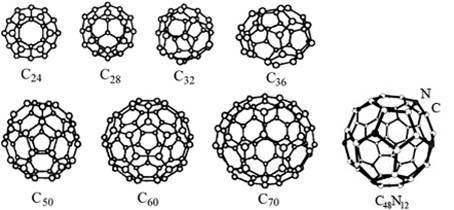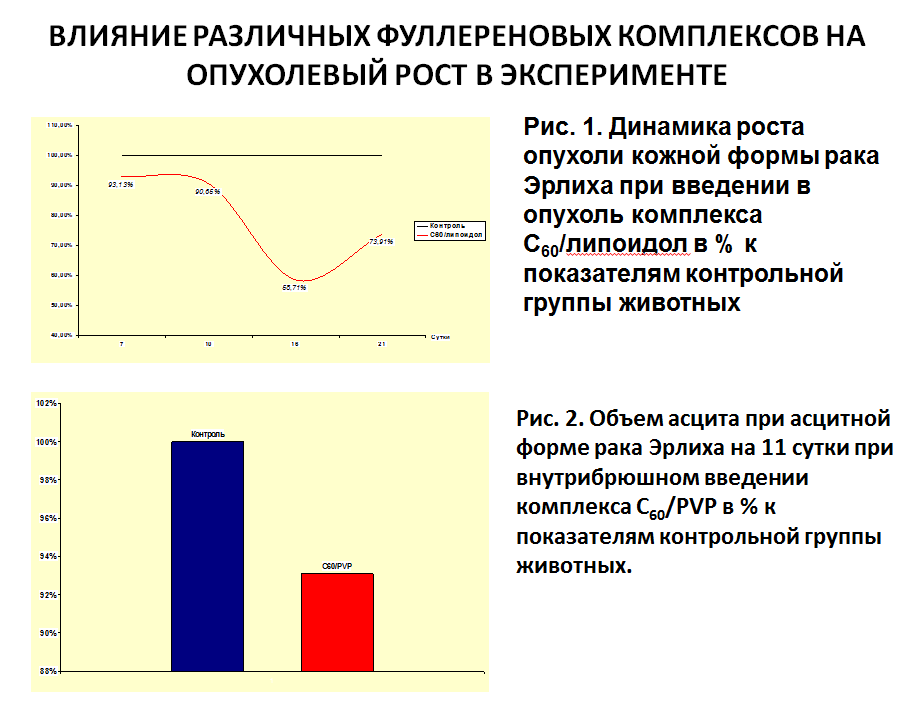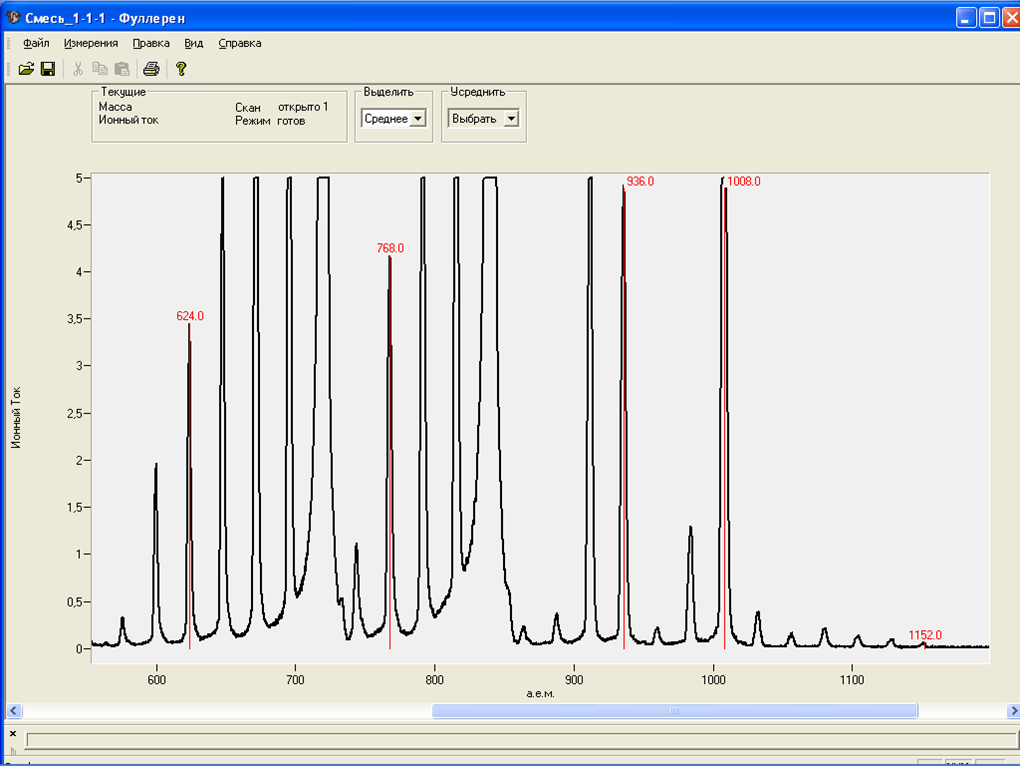Fulleren, step forward
Fullerene is a form of pure carbon in which atoms are interconnected into a crystal lattice resembling a soccer ball in shape. Depending on the number of atoms, fullerenes can be lower (from 24x to 70 atoms) and higher (70 or more atoms). Of practical interest are fullerene molecules with 60 and 70 atoms as the most common (C60 and C70, respectively).
Fullerenes, isomeric series:

Due to their unique properties: bactericidal, antioxidant, sorbing, fullerenes in the future have a serious prospect for use in medicine:
• Additive to organic oils, cosmetology, medical cosmetics: psoriasis, dermatitis and fungus remedies, hair loss remedies, means for getting rid of scars, stretch marks, pigmentation.
• Pharmacological preparations: anti-burn and wound healing preparations (2-2.5 times faster healing process, anesthesia), non-toxic antibacterial and disinfectants, medicines for gastritis, ulcers, gastrointestinal cancer, tuberculosis and bacterial ulcers, ACNE. Ophthalmic and gynecological preparations (does not corrode the mucous membrane). Immunostimulating and antiallergic drugs (at the same time). Potentially a cure for cancer.
• Supplements: fullerene is a powerful antioxidant (antioxidant ability is 135 times higher than ascorbic acid), neutralizes free radicals.
Wound coverage using hydrated fullerenes (fullerenols C (60/70) OH (X)):

Effect of fullerenes on tumor growth:

Being a stable form of carbon nanoparticles, fullerenes provide homogeneous properties of technical single crystals and films.
Electronics and optics:
• Non-linear optics: films for optical lenses.
• Superconducting compounds: high density silicon carbide derived from fullerenes.
• Solar cells: high-density silicon carbide films increase the efficiency of solar energy by up to + 30%.
Industrial and construction materials:
• Additive to industrial oils, rubbers and plastics: engine oil efficiency increases by 2–3 times, the service life of rubber and plastic products increases by 4 times, and the cold resistance of these products also increases.
• Protective coatings: improved non-stick coatings and low friction coatings.
• Dispersion hardened composite materials.
• Fullerene additives for the growth of diamond films.
Fullerene film:

Fullerite model:

The only way to obtain significant amounts of fullerene is the so-called Kretschmer’s method, where two carbon rods are burned in a plasma arc. It allows you to get 0.2-0.5% of fullerene from the mass of the rods. This is a slow process and it takes several days and a huge amount of electricity to produce a significant amount of product (modern plants consume about 50 kW). But this is not all, then it is necessary to “wash” the fullerene from unnecessary carbon black. This, depending on the technology used, takes 2 to 4 weeks. This consumes a large amount of solvent, because fullerene does not dissolve to water.
Schematic diagram of the installation of Kretschmer:

Thus, due to the exorbitant complexity and high cost of production, fullerenes always aroused purely scientific interest, but no more.
Russian scientists at the Laboratory of Nanocarbon Materials at SPbSPU have achieved significant results both in the field of obtaining fullerene, and in the field of washing it and obtaining its important modifications. The methods developed by them make it possible to intensify the combustion process of carbon rods, which made it possible to increase the efficiency of the transition of soot to fullerene to units of a percent (15–20 times).
The laboratory also analyzes the quality of the product. For this, the most modern control methods are used: chromatographic, IR spectrometric, mass spectrometric.
Mass spectrogram of fullerene:

At the moment, the laboratory is actively collaborating with several medical and technical research institutes. The result of such cooperation has already been completed research and patents ( one , two ).
Fullerenes, isomeric series:

Due to their unique properties: bactericidal, antioxidant, sorbing, fullerenes in the future have a serious prospect for use in medicine:
• Additive to organic oils, cosmetology, medical cosmetics: psoriasis, dermatitis and fungus remedies, hair loss remedies, means for getting rid of scars, stretch marks, pigmentation.
• Pharmacological preparations: anti-burn and wound healing preparations (2-2.5 times faster healing process, anesthesia), non-toxic antibacterial and disinfectants, medicines for gastritis, ulcers, gastrointestinal cancer, tuberculosis and bacterial ulcers, ACNE. Ophthalmic and gynecological preparations (does not corrode the mucous membrane). Immunostimulating and antiallergic drugs (at the same time). Potentially a cure for cancer.
• Supplements: fullerene is a powerful antioxidant (antioxidant ability is 135 times higher than ascorbic acid), neutralizes free radicals.
Wound coverage using hydrated fullerenes (fullerenols C (60/70) OH (X)):

Effect of fullerenes on tumor growth:

The use of fullerene spray on a burn of the 3rd degree
1st day of application:

14th day of application:

AKNE before and after a 10-day course of treatment:


14th day of application:

AKNE before and after a 10-day course of treatment:

Being a stable form of carbon nanoparticles, fullerenes provide homogeneous properties of technical single crystals and films.
Electronics and optics:
• Non-linear optics: films for optical lenses.
• Superconducting compounds: high density silicon carbide derived from fullerenes.
• Solar cells: high-density silicon carbide films increase the efficiency of solar energy by up to + 30%.
Industrial and construction materials:
• Additive to industrial oils, rubbers and plastics: engine oil efficiency increases by 2–3 times, the service life of rubber and plastic products increases by 4 times, and the cold resistance of these products also increases.
• Protective coatings: improved non-stick coatings and low friction coatings.
• Dispersion hardened composite materials.
• Fullerene additives for the growth of diamond films.
Fullerene film:

Fullerite model:

The only way to obtain significant amounts of fullerene is the so-called Kretschmer’s method, where two carbon rods are burned in a plasma arc. It allows you to get 0.2-0.5% of fullerene from the mass of the rods. This is a slow process and it takes several days and a huge amount of electricity to produce a significant amount of product (modern plants consume about 50 kW). But this is not all, then it is necessary to “wash” the fullerene from unnecessary carbon black. This, depending on the technology used, takes 2 to 4 weeks. This consumes a large amount of solvent, because fullerene does not dissolve to water.
Schematic diagram of the installation of Kretschmer:

Thus, due to the exorbitant complexity and high cost of production, fullerenes always aroused purely scientific interest, but no more.
Russian scientists at the Laboratory of Nanocarbon Materials at SPbSPU have achieved significant results both in the field of obtaining fullerene, and in the field of washing it and obtaining its important modifications. The methods developed by them make it possible to intensify the combustion process of carbon rods, which made it possible to increase the efficiency of the transition of soot to fullerene to units of a percent (15–20 times).
The laboratory also analyzes the quality of the product. For this, the most modern control methods are used: chromatographic, IR spectrometric, mass spectrometric.
Mass spectrogram of fullerene:

At the moment, the laboratory is actively collaborating with several medical and technical research institutes. The result of such cooperation has already been completed research and patents ( one , two ).
